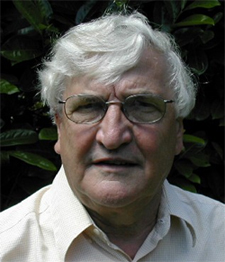
If your flight has been cancelled today because of high level volcanic ash from Iceland, read this. Ted Nield* describes the first time a pilot (just) survived an encounter with volcanic dust, 11km high.
Geoscientist Online 15 April 2010
“Good evening ladies and gentlemen. This is your captain speaking. We have a small problem. All four engines have stopped. We are doing our damnedest to get them going again. I trust you are not in too much distress.”
Captain Eric Moody, flight announcement, 24 June 1982.
On the clear, moonless night of 24 June 1982, Scheduled BA flight 009 took off from sweltering Kuala Lumpur bound for Australia. There were 249 passengers on board the plane, which was laden with 91,000kg of fuel for the five-hour flight to Perth.
At the controls was Captain Eric Moody (pictured recently). As they levelled out at the 747’s cruising altitude of 11,300 metres, the crew ate their evening meal, just as the flight passed south of the city of Jakarta.
Everything was routine; though “routine” for a jumbo jet involves some fairly impressive figures. For example, through each of the aeroplane's four Rolls Royce engines, 150 tonnes of air was being sucked every minute. Think about what volume of air you need – even at sea level - to weigh a hundred and fifty tonnes.
This may be some help. A cubic metre of air at sea level weighs 1.204kg at 20 degrees Celsius, according to the International Standard Atmosphere. But at the cruising altitude of flight BA 009, one cubic metre of air only weighs about 360 grams; so the 600,000kg of air that Speedbird 9 needed every minute occupied a space of about 1.67 million cubic metres. This means that, up there, in a mere 10 hours, one thousand million cubic metres of the Earth’s atmosphere will pass through a 747's engines. On its round trip, the KL to Perth service would gobble up about a cubic kilometre of the Earth's atmosphere. These facts were to prove significant in the tense moments ahead.
The function of all this air entering the maw of the jet’s engines is to undergo compression and mix with some of the 91,000 kg of kerosene that is squirted into it from fine nozzles. These are surrounded by "swirl vanes" that break the fuel into a fine mist - rather like the spiral grooves inside the head of a domestic spray gun. The mixture is then immediately ignited. Oxygen in the air combines with the fuel, at over 700°C. The massively expanding exhaust gases exit the four engines and thrust the aeroplane forwards at 800km per hour.
The speed of the plane was also to be significant in the coming moments. The difference in speed between plane and air means that anything in the air will collide with it at about 222 metres per second. A rifle bullet, by comparison, can travel at anything between 180 and 1220 metres per second. So it is a good thing, then, that under normal conditions there are no rocks in the air, 11,300 metres up.
Unfortunately on that night, there were - but nobody could see them because their average diameter was only seventy five thousandths of a millimetre. Worse still, the temperature in the engines was high enough to melt finely powdered rock.
His dinner eaten, Captain Moody left the cabin and made his way down the spiral stairs to the first class section in search of an unoccupied toilet; but before he could find one he was called back. Moody remembers noticing as he turned some little puffs of what seemed to be smoke issuing from vents on the floor. There was also an odour that reminded him of the smell left behind after electrical sparks have flown.